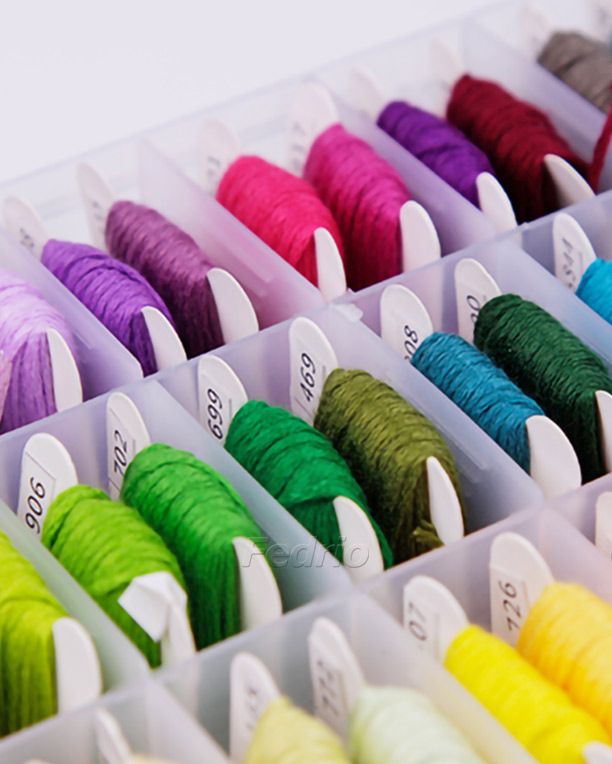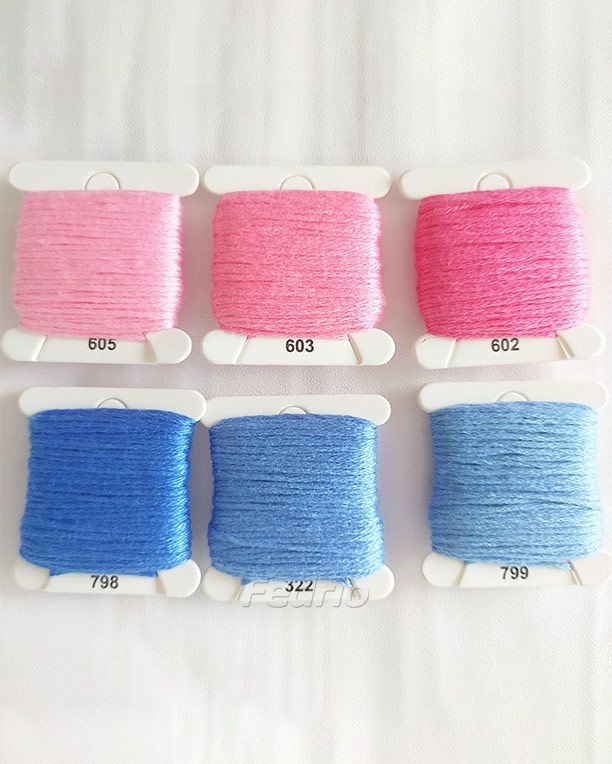There are 3 different types of sewing threads for sewing various clothing trims or accessories: natural fiber, synthetic fiber, and mixed sewing thread. Sewing thread is the main thread material, which has both practical and decorative functions. The quality of it not only affects sewing efficiency and processing cost but affects the appearance quality of finished garments.
Sewing thread types
1. Natural fiber sewing thread
a. Cotton sewing thread:
Cotton sewing thread uses cotton fiber as raw material. It is a sewing thread made by refining, sizing, waxing, and other processes. Cotton sewing thread can be divided into no light (or soft thread), silk light, and wax light.
Cotton sewing thread has high strength and good heat resistance, suitable for high-speed sewing and durable pressing. Therefore, it is mainly used for sewing cotton fabrics, genuine leather, and high-temperature ironing clothes. The disadvantage is poor elasticity and wears resistance.
b. Silk thread:
Filament thread or silk thread is made of natural silk, with excellent luster. Its strength, elasticity, and wear resistance are better than cotton thread. Therefore, they are suitable for sewing all kinds of silk work clothes, high-end woolen work clothes, fur and leatherwork clothes, etc.

2. Synthetic fiber sewing thread
a. Polyester fiber sewing thread:
This is the most widely used and popular sewing thread at present. We make it from polyester filaments or staple fibers. Polyester fiber sewing thread has high strength and good elasticity. It is also wear-resistant and has low shrinkage.
Therefore, it is ideal for the sewing of denim, casual wear, leather products, wool, and military uniforms. The caveat here is that polyester sutures have a low melting point. Thus, it is easy to melt when sewing at high speed, and causing the thread to break. Therefore, it is necessary to choose the appropriate needle.

b. Nylon sewing thread:
Nylon sewing thread is made of pure nylon multifilament. It has three types: filament thread, short fiber thread, and elastic deformation thread. At present, the main variety is nylon filament thread. It has a large extension and good elasticity. Therefore, it is suitable for sewing chemical fiber, woolen, leather, and elastic work clothes.
The biggest advantage of nylon sewing thread is its transparency. Since the thread is transparent, the difficulty of sewing the wiring is reduced. The prospects are very broad. At present, this type of thread is mainly used for decals, cutting edges, and other parts that are not easily stressed.
c, Vinylon sewing thread:
Vinylon sewing thread is made of vinylon fiber. Its strength is high and the stitching is smooth. Therefore, it suits for sewing thick canvas, furniture cloth, labor protection supplies, etc.
D. Polyacrylonitrile fiber sewing thread:
It is made of polyacrylonitrile fiber. And, it is ideal for decorative thread and embroidery thread. Besides, its spinning yarn has a low twist and bright color.

3. Mixed sewing thread
A. Polyester/cotton sewing thread:
Polyester/cotton sewing thread is made of 65% polyester and 35% cotton blended synthetic fabric. They have the advantages of both polyester and cotton. Polyester/cotton sewing thread can meet the requirements of strength, wear resistance, and shrinkage. And it can also overcome the defect that polyester fiber is not heat-resistant. So it is very suitable for high-speed sewing. Then, they are suitable for all kinds of work clothes. Such as Cotton, polyester/cotton, etc.
b. Core-spun sewing thread:
Core-spun sewing thread has a filament core. And natural fibers cover it outside. The strength of the core-spun sewing thread depends on the core thread. While the wear and heat resistance depends on the outer yarn. Therefore, the core-spun sewing thread is suitable for high-speed sewing. And it’s also suitable for workwear that requires high sewing sturdiness.

The production process of polyester sewing thread
- Cleaning and rolling:
Pour the polyester staple fibers into the turntable, and disrupt and combine the original regular fibers to form a rolled fiber block.
- Carding and splicing:
The carding machine will continue to card and splice the large package fibers into small strips.
- Roving, spun yarn:
The roving and spinning frame will adjust the stripped fiber to the desired count. Such as the 50S, 40S, 20S, 30S, and other single yarns.
- Stitching and twisting:
The stitching machine twists the single yarn into the required number of strands. Such as 50S/2, 40S/2, 20S/2, 30S/3, etc.
- Twisting and loosening:
We make the finished strands into skeins or bobbins, ready for dyeing.
- Dyeing and packaging:
Dyeing according to the customer’s needs, and shipping.

What are the main qualities of a sewing thread?
- The surface is smooth and smooth, with uniform color and sewability.
- Certain fastness and abrasion resistance.
- Small shrinkage rate.
Synthetic fiber sewing thread has high strength, wear resistance, corrosion resistance, and small shrinkage. Moreover, they have largely replaced cotton thread. When sewing elastic fabrics, we often use low-elastic polyester sewing thread. In order to avoid mismatches between the sewing thread and the fabric color, please use a transparent synthetic filament thread. Because the thread is transparent, it is suitable for sewing various colors of fabrics. And we wholesale stock online sewing thread for you. The different types of sewing threads have many applications. Then, we have an article that is 9 eco-friendly fabrics you should know. Maybe you can learn something from it.



What are the common models and specifications of polyester threads?
Common types of polyester threads are: 20s/2, 20s/3, 30s/2, 30s/3, 40s/2, 40s/3, 50s/2, 50s/3, 60s/2, 60s/3. Among which the most common is 40s/2.
What does the model of this polyester thread mean?
The first half of “/” indicates the yarn count. The 20s is 20 yarns, 30s is 30 yarns. What is “count”? The count refers to the weight of one pound (453.6g). The total length of yarn spun from the raw material is several 840 yards (1 yard = 91.4 cm). A total length of 16800 is the 20s, and a total length of 33600 is 40s. Is it very complicated, right? In fact, we just need to know that the larger the number in front of the s, the finer the yarn.
What does the 2 or 3 after “/” mean? This refers to the number of strands of yarn. Now, you can take a closer look at the sewing thread you have on hand. That’s not a single yarn, but 2 or 3 strands twisted together. The expression of 2 strands is /2, and the expression of 3 strands is /3. 20s/2 means that the sewing thread is twisted by 2 strands of 20 yarns. And 20s/3 means that the sewing thread is twisted from 3 strands of 20 yarns.
Just like selecting needles, use thin threads for thin fabrics and thick threads for thick materials. 40s/2 thread suits household sewing. Also, we can use it to sew ordinary fabrics. Then, we can use 20s/2 for thick materials or decorative lines on the surface.

Tips
1. When choosing a sewing thread, select what material it should be;
2. Whether the sewing thread is neat after molding. But, if it is not neat, there may be many inner joints or uneven thickness;
3. The fluffing degree of the sewing thread;
4. Whether the elongation of the sewing thread meets the standard you need;
5. Whether the roughness meets international and national standards;
6. The length detection can calculate the gram-to-weight ratio according to different specifications;
7. When you receive the sewing thread, the yarn should dry. Otherwise, it is easy to mold or fades;
8. No. 11 and No. 14 are necessary needles. General-purpose of the fine thread is 40s/2. 20s/2 is a good choice for thousand-seam basting thread;
9. The popular name of the sewing thread model will remove the “s/” in the middle. For example, we will call 40s/2 directly 402;
10. When your sewing machine has problems. Such as jumpers and broken threads. It is often due to the selection of inappropriate needles and threads.